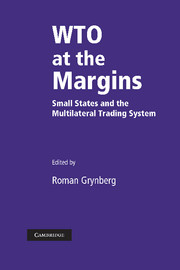Book contents
- Frontmatter
- Contents
- List of figures and appendices
- List of tables
- List of contributors
- Introduction
- Part I Theory and evidence
- Part II WTO and small economies
- Part III WTO dispute settlement
- 11 Small states in the banana dispute
- 12 Impact of changes in the European Union's policy for banana imports on the Eastern Caribbean Region (1992–2002)
- 13 Jamaica and the case in the WTO against the European Communities regime for the importation, sale and distribution of bananas (1992–2001)
- 14 WTO complaints by Australia and Brazil regarding the EU sugar regime
- 15 Reform of EU export subsidies on sugar: the legal and economic implications for the ACP countries
- 16 Analysis of the impact of opening up the EU import market for canned tuna on ACP countries
- Part IV Negotiating issues and institutional arrangements
- Index
14 - WTO complaints by Australia and Brazil regarding the EU sugar regime
Published online by Cambridge University Press: 05 May 2010
- Frontmatter
- Contents
- List of figures and appendices
- List of tables
- List of contributors
- Introduction
- Part I Theory and evidence
- Part II WTO and small economies
- Part III WTO dispute settlement
- 11 Small states in the banana dispute
- 12 Impact of changes in the European Union's policy for banana imports on the Eastern Caribbean Region (1992–2002)
- 13 Jamaica and the case in the WTO against the European Communities regime for the importation, sale and distribution of bananas (1992–2001)
- 14 WTO complaints by Australia and Brazil regarding the EU sugar regime
- 15 Reform of EU export subsidies on sugar: the legal and economic implications for the ACP countries
- 16 Analysis of the impact of opening up the EU import market for canned tuna on ACP countries
- Part IV Negotiating issues and institutional arrangements
- Index
Summary
Introduction
On 27 September 2002, the Governments of Australia and Brazil (the ‘Complainants’) filed requests for consultations with the European Communities (EC) alleging that the structure of its sugar market violates its obligations under certain agreements of the World Trade Organisation (WTO). If the Complainants are successful in their challenge, the EC may find itself obligated to change the nature of its sugar market in order to bring it into compliance with WTO obligations. Such changes could result in a significant reduction in price supports from which domestic and certain African, Caribbean and Pacific (ACP) suppliers benefit.
The EU Common Market Organisation for sugar
General structure
The EU's Common Market Organisation (CMO) for sugar has the following five principal features:
production quota scheme
guaranteed price and intervention mechanism
export refund programme
production levies
preferential import programme.
Quota scheme
Under the CMO, processors are required to pay growers a guaranteed minimum beet price, and the EC will pay producers a fixed ‘intervention price’ for a certain quantity (quota) of refined white sugar per EC Member State. National quotas are allocated to individual sugar-producing factories. There are two types of quota, A and B, the main difference being the level of the production levies applied to them. Only ‘quota sugar’ can be sold in the EC; sugar produced in excess of quota (‘C-sugar’) must be exported without any export refund. Thus, the quota system acts as a limitation on the supply of sugar on the EC sugar market.
- Type
- Chapter
- Information
- WTO at the MarginsSmall States and the Multilateral Trading System, pp. 522 - 534Publisher: Cambridge University PressPrint publication year: 2006



